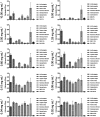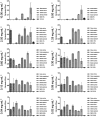Unleashing nature's defense: potent antimicrobial power of plant extracts against oral pathogens and Streptococcus mutans biofilms
- PMID: 39726767
- PMCID: PMC11669686
- DOI: 10.3389/froh.2024.1469174
Unleashing nature's defense: potent antimicrobial power of plant extracts against oral pathogens and Streptococcus mutans biofilms
Abstract
Objectives: The increasing demand for alternatives to antibiotics against resistant bacteria has led to research on natural products. The aim of this study was to analyze the antimicrobial and antibiofilm activity of 16 Mediterranean herb extracts.
Materials and methods: The extracts were analyzed using High Performance Thin Layer Chromatography. The minimum inhibitory concentration and minimum bactericidal concentration of the extracts from Achillea taygetea, Cistus creticus ssp. creticus, Cistus monspeliensis, Lavandula stoechas, Mentha aquatica, Mentha longifolia, Origanum vulgare, Phlomis cretica, Rosmarinus officinalis, Salvia sclarea, Satureja parnassica, Satureja thymbra, Sideritis euboea, Sideritis syriaca, Stachys spinosa, and Thymus longicaulis were determined against eight oral bacteria and fungus Candida albicans. Microtiter plate test was conducted to evaluate the antibiofilm activity against Streptococcus mutans.
Results: Overall, all tested extracts efficiently suppressed the growth of obligate anaerobic bacteria. When applied at concentrations ≥0.15 mg/ml, the extracts exhibited moderate to high antibiofilm activity comparable to that of chlorhexidine (CHX) against S. mutans. Interestingly, R. officinalis (MIC: 0.01-0.06 mg/ml) and O. vulgare (MIC: 0.04-1.25 mg/ml) demonstrated the highest antibacterial activity against oral bacteria. Additionally, R. officinalis and L. stoechas significantly inhibited S. mutans biofilm formation at 0.15 mg/ml.
Conclusions: The tested plant extracts can be considered as alternative natural antimicrobial and antibiofilm agents.
Clinical relevance: Mediterranean herb extracts show promise as natural alternatives to combat oral bacteria and biofilm formation, offering potential new therapies for infectious oral diseases in the context of antibiotic resistance.
Keywords: Mediterranean herb; antimicrobial activity; biofilm; natural extract; oral disease.
© 2024 Hickl, Argyropoulou, Al-Ahmad, Hellwig, Skaltsounis, Wittmer, Vach and Karygianni.
Conflict of interest statement
The authors declare that the research was conducted in the absence of any commercial or financial relationships that could be construed as a potential conflict of interest.
Figures
Similar articles
-
Antibiofilm potential of plant extracts: inhibiting oral microorganisms and Streptococcus mutans.Front Dent Med. 2025 Apr 4;6:1535753. doi: 10.3389/fdmed.2025.1535753. eCollection 2025. Front Dent Med. 2025. PMID: 40255688 Free PMC article.
-
Mediterranean herb extracts inhibit microbial growth of representative oral microorganisms and biofilm formation of Streptococcus mutans.PLoS One. 2018 Dec 12;13(12):e0207574. doi: 10.1371/journal.pone.0207574. eCollection 2018. PLoS One. 2018. PMID: 30540782 Free PMC article.
-
The antimicrobial and antibiofilm effects of three herbal extracts on Streptococcus mutans compared with Chlorhexidine 0.2% (in vitro study).J Med Life. 2022 Apr;15(4):526-532. doi: 10.25122/jml-2021-0189. J Med Life. 2022. PMID: 35646170 Free PMC article.
-
In vitro antimicrobial and antibiofilm screening of eighteen Iranian medicinal plants.BMC Complement Med Ther. 2024 Mar 28;24(1):135. doi: 10.1186/s12906-024-04437-x. BMC Complement Med Ther. 2024. PMID: 38549139 Free PMC article.
-
The effect of hydro alcoholic extract of seven plants on cariogenic bacteria--an in vitro evaluation.Oral Health Dent Manag. 2014 Jun;13(2):395-401. Oral Health Dent Manag. 2014. PMID: 24984654
Cited by
-
Antibiofilm potential of plant extracts: inhibiting oral microorganisms and Streptococcus mutans.Front Dent Med. 2025 Apr 4;6:1535753. doi: 10.3389/fdmed.2025.1535753. eCollection 2025. Front Dent Med. 2025. PMID: 40255688 Free PMC article.
References
LinkOut - more resources
Full Text Sources
Molecular Biology Databases




